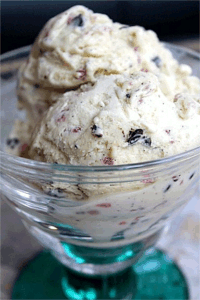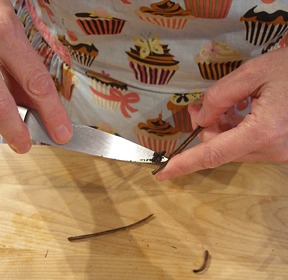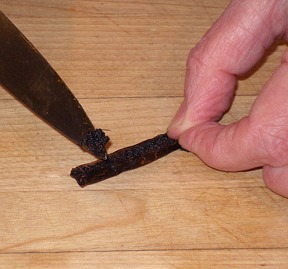 The deepest vanilla flavor is found in the thousands of tiny “caviar” seeds, scraped from the dark, sticky pulp from the inside of a soft whole vamilla bean. They impart pleasingly strong flavor when used in baking recipes. The best-quality beans come from Mexico, Madagascar, and Indonesia. They can be purchased from the grocery store (not as fresh), a specialty food store and online. When kept tightly sealed in the refrigerator, vanilla beans last for up to six months.
The deepest vanilla flavor is found in the thousands of tiny “caviar” seeds, scraped from the dark, sticky pulp from the inside of a soft whole vamilla bean. They impart pleasingly strong flavor when used in baking recipes. The best-quality beans come from Mexico, Madagascar, and Indonesia. They can be purchased from the grocery store (not as fresh), a specialty food store and online. When kept tightly sealed in the refrigerator, vanilla beans last for up to six months.
SARAH SAYS: 1 vanilla bean (approximately 2-inches), halved and scraped, is equivalent to approximately 1 tablespoon pure vanilla extract.
I like strong flavors, so I add the vanilla seeds in addition to the extract called for in the recipe!
HOW TO EXTRACT OR SCRAPE THE VANILLA SEEDS
This how to baking technique is used with the 7-Minute Vanilla Bean Icing Recipe Tutorial.
Scrape the vanilla beans right before using in a recipe. Choose beans that are plump, pliable and feel dense and somewhat squishy. Penzeys Spices says that the longer the bean, the better the flavor. Sometimes vanilla beans are speckled with a pale, whitish dust. This is simply crystallized vanillin — the substance that gives them their flavor — and is nothing to worry about. After scraping the vanilla bean, it can be reused to scent a recipe, such as sugar or to infuse flavor into milk or heavy cream before using.
SARAH SAYS: If you have scraped the beans out in advance, they will have less flavor, but nonetheless, still contribute.
To do:
1. Place the bean on a flat surface. Hold the bean flat with one hand, and split the bean in half lengthwise with a sharp paring knife.
2. Use the back side of the paring knife's blade to scrape the dark, moist pulp from the bean; that way you will not get any strings from the vanilla pod in the seeds.


3. Use immediately.


